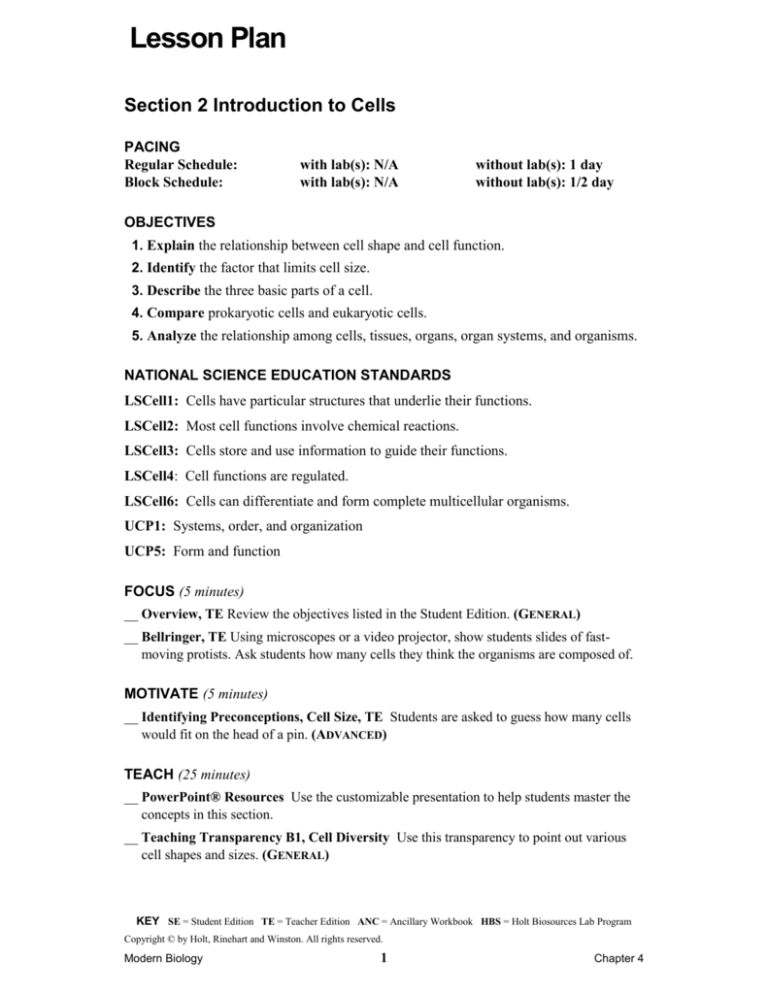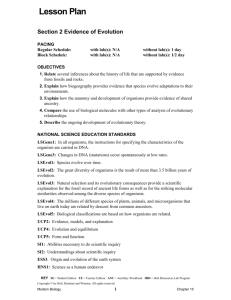
Lesson Plan
Section 2 Introduction to Cells
PACING
Regular Schedule:
Block Schedule:
with lab(s): N/A
with lab(s): N/A
without lab(s): 1 day
without lab(s): 1/2 day
OBJECTIVES
1. Explain the relationship between cell shape and cell function.
2. Identify the factor that limits cell size.
3. Describe the three basic parts of a cell.
4. Compare prokaryotic cells and eukaryotic cells.
5. Analyze the relationship among cells, tissues, organs, organ systems, and organisms.
NATIONAL SCIENCE EDUCATION STANDARDS
LSCell1: Cells have particular structures that underlie their functions.
LSCell2: Most cell functions involve chemical reactions.
LSCell3: Cells store and use information to guide their functions.
LSCell4: Cell functions are regulated.
LSCell6: Cells can differentiate and form complete multicellular organisms.
UCP1: Systems, order, and organization
UCP5: Form and function
FOCUS (5 minutes)
__ Overview, TE Review the objectives listed in the Student Edition. (GENERAL)
__ Bellringer, TE Using microscopes or a video projector, show students slides of fastmoving protists. Ask students how many cells they think the organisms are composed of.
MOTIVATE (5 minutes)
__ Identifying Preconceptions, Cell Size, TE Students are asked to guess how many cells
would fit on the head of a pin. (ADVANCED)
TEACH (25 minutes)
__ PowerPoint® Resources Use the customizable presentation to help students master the
concepts in this section.
__ Teaching Transparency B1, Cell Diversity Use this transparency to point out various
cell shapes and sizes. (GENERAL)
KEY SE = Student Edition TE = Teacher Edition ANC = Ancillary Workbook HBS = Holt Biosources Lab Program
Copyright © by Holt, Rinehart and Winston. All rights reserved.
Modern Biology
1
Chapter 4
Lesson Plan
__ Teaching Transparency B2, Relationship Between Surface Area and Volume Use this
transparency to discuss the relationship between surface area and volume. (GENERAL)
__ Teaching Transparency B3, Surface-Area-to-Volume Ratio Use this transparency to
discuss the importance of the surface-area-to-volume ratio. (GENERAL)
__ Quick Lab, Comparing Surface Cells, SE Students examine slides of plant stems and
human skin. (GENERAL)
__ Datasheet for In-Text Labs, Comparing Surface Cells, ANC Students use the
datasheet to complete the in-text lab. (GENERAL)
__ Teaching Tip, The Effect of Cell Size, TE Students place potato cubes in water with
food coloring to see how surface-area-to-volume ratio affects dye penetration. (GENERAL)
__ Skill Builder, Math Skills, TE Students are asked to calculate the surface area and
volume of 1 cm, 3 cm, and 6 cm cubes. (BASIC)
__ Activity, Permeability, TE Students demonstrate and discuss how the smell of perfume
can pass through a balloon. (BASIC)
__ Teaching Tip, Cytoplasmic Streaming, TE Have students locate the nucleus and observe
cytoplasmic streaming in live amoebas. (GENERAL)
__ Teaching Transparency B4, Animal Cell Use this transparency to review the parts of a
typical animal cell. (GENERAL)
__ Demonstration, Cell Size, TE Demonstrate the relative sizes of prokaryotic and
eukaryotic cells using scale models. (GENERAL)
__ Careers in Biology, Medical Pathologist, TE Use this feature to encourage students to
consider careers that require biology skills and knowledge. (GENERAL)
__ Teaching Tip, Organ Systems, TE Tell students how some organ systems in simple
eukaryotes take on multiple functions. (GENERAL)
__ Teaching Transparency B5, Prokaryotic Cell Use this transparency to review the basic
structure of a prokaryote. (GENERAL)
__ Teaching Transparency B6, Comparing Prokaryotes and Eukaryotes Use this
transparency to review the classification and characteristics of these organisms.
(GENERAL)
__ Teaching Transparency B7, Organization in Multicellular Organisms Use this
transparency to discuss levels of organization in a multicellular organism. (GENERAL)
CLOSE (10 minutes)
__ Section Review, SE Students are assessed through questions about key concepts and
questions that require critical thinking skills. (GENERAL)
__ Reteaching, Cell Function, TE Students are asked to brainstorm the function of cells
based on a picture. (BASIC)
__ Quiz, TE Students answer true-false questions about this section. (GENERAL)
KEY SE = Student Edition TE = Teacher Edition ANC = Ancillary Workbook HBS = Holt Biosources Lab Program
Copyright © by Holt, Rinehart and Winston. All rights reserved.
Modern Biology
2
Chapter 4
Lesson Plan
OTHER RESOURCE OPTIONS
__ Quick, Data, and Math Labs, Modeling Cells: Surface Area to Volume, HBS Students
compare living and nonliving things and identify traits living things have in common.
(BASIC)
__ Quick, Data, and Math Labs, Calculating Surface Area and Volume, HBS Students
learn to calculate the ratio of surface area to volume. (ADVANCED)
__ Active Reading Worksheets, ANC Students are asked to analyze a passage related to the
chapter text and answer questions about the passage. (BASIC)
__ Visual Concepts CD-ROM Use this multimedia resource to reinforce selected concepts
from the chapter.
__ Basic Skills Worksheet, Scale Drawings, One-Stop Planner Use this worksheet to
review basic science skills. (BASIC)
__ Basic Skills Worksheet, Length, Area, and Volume Measurement, One-Stop Planner
Use this worksheet to review basic science skills. (BASIC)
__ Problem Solving Worksheet, Ratio and Proportions, One-Stop Planner Use this
worksheet to review math skills used in science. (GENERAL
KEY SE = Student Edition TE = Teacher Edition ANC = Ancillary Workbook HBS = Holt Biosources Lab Program
Copyright © by Holt, Rinehart and Winston. All rights reserved.
Modern Biology
3
Chapter 4









